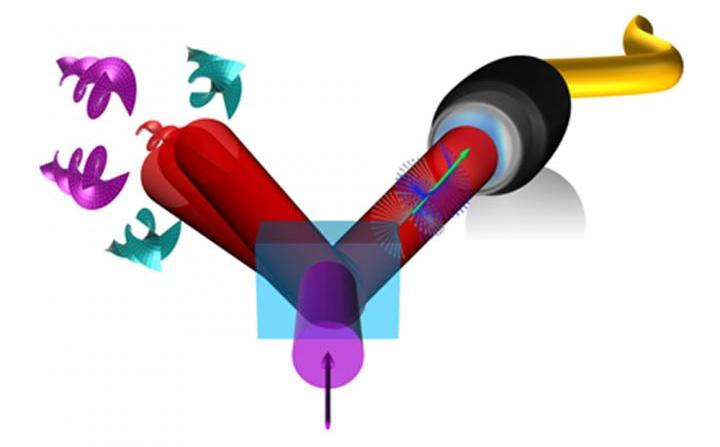Jan 27 2020
Researchers at the University of the Witwatersrand in Johannesburg, South Africa, and Huazhang University of Science and Technology in Wuhan, China, have performed a new study, with interesting outcomes for secure transfer of data over optical fiber networks.
 Two photons are entangled, one in polarization and the other in orbital angular momentum—twisted light. By passing the polarization photon through the fiber and keeping the twisted light in air, multi-dimensional entanglement transport is possible even over single mode fiber. Image Credit: University of the Witwatersrand.
Two photons are entangled, one in polarization and the other in orbital angular momentum—twisted light. By passing the polarization photon through the fiber and keeping the twisted light in air, multi-dimensional entanglement transport is possible even over single mode fiber. Image Credit: University of the Witwatersrand.
The researchers have shown that it is possible to transmit multiple quantum patterns of twisted light over a traditional fiber link that, ironically, supports only a single pattern. The outcome is a new way to achieve a future quantum network, exploiting multiple dimensions of entangled quantum light.
The research was recently published online in Science Advances, by a team headed by Professor Andrew Forbes of the School of Physics at Wits University, along with a team headed by Professor Jian Wang at HUST. In their study titled “Multi-dimensional entanglement transport through single mode fiber,” the researchers demonstrate a new paradigm for achieving a future quantum network.
The researchers demonstrated that it is possible to access multiple patterns of light after a communication link of traditional optical fiber, that ironically can support only one pattern. They realized this quantum trick by designing entanglement in two degrees of freedom of light, polarization and pattern, sending the polarized photon down the fiber and accessing the various patterns using the other photon.
In essence, the research introduces the concept of communicating across legacy fibre networks with multi-dimensional entangled states, bringing together the benefits of existing quantum communication with polarised photons with that of high-dimension communication using patterns of light.
Andrew Forbes, Professor, School of Physics, University of the Witwatersrand
A New Twist, a New Paradigm
Today’s communication systems are extremely fast, but not essentially secure. To enhance their security, the laws of Nature are used by scientists to encode by leveraging the strange properties of the quantum realm, for example, while using Quantum Key Distribution (QKD) for secure communication.
Here, the term “Quantum” refers to the strange action at a distance so abominated by Einstein: quantum entanglement. Over the past few decades, quantum entanglement has been widely investigated for a range of quantum information protocols, specifically rendering communication more secure by means of QKD.
The information capacity is restricted through the use of what are called “qubits” (2D quantum states). However, such states can be easily obtained across fiber links if polarization is used as a degree of freedom to perform encoding. The spatial pattern of light, its pattern, is another degree of freedom that offers the advantage of high-dimensional encoding.
Although several patterns are available for use, this necessitates custom fiber optical cable, making it inappropriate for networks that already exist. In this study, the researchers have discovered a new technique to balance the two extremes. They achieved it by merging polarization qubits with high-dimensional spatial modes to develop multi-dimensional hybrid quantum states.
“The trick was to twist the one photon in polarisation and twist the other in pattern, forming ‘spirally light’ that is entangled in two degrees of freedom,” stated Forbes.
Since the polarisation entangled photon has only one pattern it could be sent down the long-distance single-mode fibre (SMF), while the twisted light photon could be measured without the fibre, accessing multi-dimensional twisted patterns in the free-space. These twists carry orbital angular momentum (OAM), a promising candidate for encoding information.
Andrew Forbes, Professor, School of Physics, University of the Witwatersrand
Overcoming the Present Challenges
Although quantum communication using high-dimensional spatial modes (for instance, OAM modes) holds potential, it is possible only in exckusively designed multi-mode fiber, which, however, is greatly affected by mode (pattern) coupling noise. Single-mode fiber is free of this “pattern coupling” (which affects entanglement), but it can only be used for two-dimensional polarization entanglement.
The novelty in the published work is the demonstration of multi-dimensional entanglement transport in conventional single-mode fibre. The light is twisted in two degrees of freedom: the polarisation is twisted to form spirally light, and so is the pattern. This is referred to as spin-orbit coupling, here exploited for quantum communication.
Andrew Forbes, Professor, School of Physics, University of the Witwatersrand
Forbes continued, “Each transmission is still only a qubit (2D) but there are an infinite number of them because of the infinite number of twisted patterns we could entangle in the other photon.”
The researchers showed how multi-dimensional entanglement states are transferred over 250 m of single-mode fiber, revealing that it is possible to achieve an infinite number of two-dimensional subspaces. It would be possible to use each subspace for sending information, or multiplexing information to multiple receivers.
“A consequence of this new approach is that the entire high-dimensional OAM Hilbert space can be accessed, but two dimensions at a time. In some sense it is a compromise between simple 2D approaches and true high-dimensional approaches,” stated Forbes. Notably, high-dimensional states are not appropriate for transmission over traditional fiber networks, while the new technique enables the use of legacy networks.